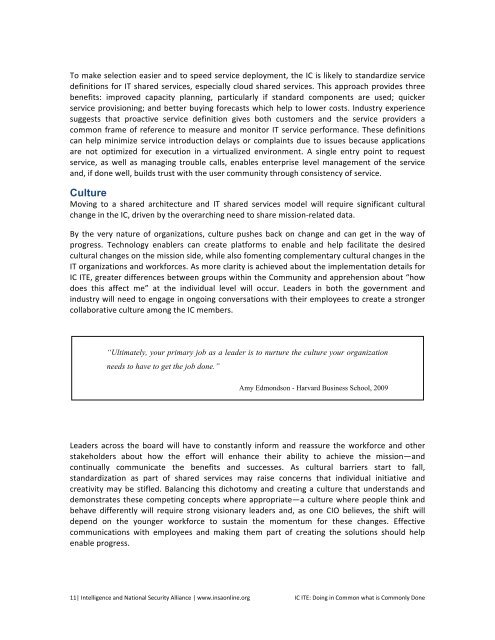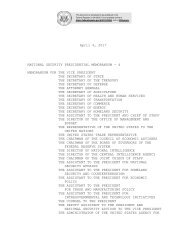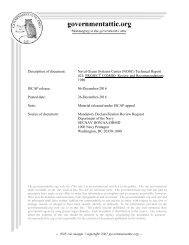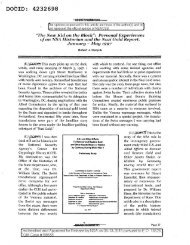insa-ic-ite
insa-ic-ite
insa-ic-ite
Create successful ePaper yourself
Turn your PDF publications into a flip-book with our unique Google optimized e-Paper software.
To make selection easier and to speed serv<strong>ic</strong>e deployment, the IC is likely to standardize serv<strong>ic</strong>e <br />
definitions for IT shared serv<strong>ic</strong>es, especially cloud shared serv<strong>ic</strong>es. This approach provides three <br />
benefits: improved capacity planning, part<strong>ic</strong>ularly if standard components are used; qu<strong>ic</strong>ker <br />
serv<strong>ic</strong>e provisioning; and better buying forecasts wh<strong>ic</strong>h help to lower costs. Industry experience <br />
suggests that proactive serv<strong>ic</strong>e definition gives both customers and the serv<strong>ic</strong>e providers a <br />
common frame of reference to measure and monitor IT serv<strong>ic</strong>e performance. These definitions <br />
can help minimize serv<strong>ic</strong>e introduction delays or complaints due to issues because appl<strong>ic</strong>ations <br />
are not optimized for execution in a virtualized environment. A single entry point to request <br />
serv<strong>ic</strong>e, as well as managing trouble calls, enables enterprise level management of the serv<strong>ic</strong>e <br />
and, if done well, builds trust with the user community through consistency of serv<strong>ic</strong>e. <br />
Culture<br />
Moving to a shared arch<strong>ite</strong>cture and IT shared serv<strong>ic</strong>es model will require signif<strong>ic</strong>ant cultural <br />
change in the IC, driven by the overarching need to share mission-‐related data. <br />
By the very nature of organizations, culture pushes back on change and can get in the way of <br />
progress. Technology enablers can create platforms to enable and help facilitate the desired <br />
cultural changes on the mission side, while also fomenting complementary cultural changes in the <br />
IT organizations and workforces. As more clarity is achieved about the implementation details for <br />
IC ITE, greater differences between groups within the Community and apprehension about “how <br />
does this affect me” at the individual level will occur. Leaders in both the government and <br />
industry will need to engage in ongoing conversations with their employees to create a stronger <br />
collaborative culture among the IC members. <br />
“Ultimately, your primary job as a leader is to nurture the culture your organization<br />
needs to have to get the job done.”<br />
Amy Edmondson - Harvard Business School, 2009<br />
Leaders across the board will have to constantly inform and reassure the workforce and other <br />
stakeholders about how the effort will enhance their ability to achieve the mission—and <br />
continually commun<strong>ic</strong>ate the benefits and successes. As cultural barriers start to fall, <br />
standardization as part of shared serv<strong>ic</strong>es may raise concerns that individual initiative and <br />
creativity may be stifled. Balancing this d<strong>ic</strong>hotomy and creating a culture that understands and <br />
demonstrates these competing concepts where appropriate—a culture where people think and <br />
behave differently will require strong visionary leaders and, as one CIO believes, the shift will <br />
depend on the younger workforce to sustain the momentum for these changes. Effective <br />
commun<strong>ic</strong>ations with employees and making them part of creating the solutions should help <br />
enable progress. <br />
11| Intelligence and National Security Alliance | www.<strong>insa</strong>online.org IC ITE: Doing in Common what is Commonly Done
















